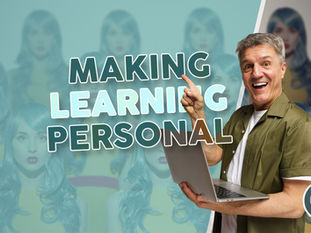
DO YOU HAVE CREDIBILITY WITH YOUR LEARNERS?
0
1
0
Imagine you’re sitting in a training session. The facilitator clicks through the slides, speaking confidently, but something nags at you. Do they really get what it’s like to do your job? Do they understand the challenges you face? In that moment, you decide whether you’ll lean in and listen… or quietly switch off.

This is the hidden power of credibility. Learners absorb knowledge better if they believe the source feels trustworthy, relevant, and worth their time. For internal Learning and Development teams, credibility is the difference between being seen as a genuine partner in growth or as ‘the department that makes courses’.
Why Credibility Matters in Learning and Development
Credibility builds trust, and trust drives engagement. When learners believe the L&D team understands their world, they are far more likely to:
Pay attention rather than multitask.
Apply new skills in the workplace.
Recommend training to peers and managers.
View L&D as an ally, not an obligation.
Neuroscience supports this. Research shows that when a story or message feels authentic and relatable, our brains react as if we’re living the experience ourselves. That’s why credible trainers don’t just pass on knowledge, but transport learners into a narrative they want to be part of.
And commercially, credibility pays off. Organisations with high learner trust in training see greater transfer of skills, stronger ROI, and better retention of top talent.
How to Identify Your Credibility with Learners
You can’t improve credibility if you don’t know where you stand. Here are three practical ways to assess it:
Learner Surveys with a Credibility Lens
Don’t just ask if training was ‘useful.’ Ask: Did you feel this session reflected the realities of your role? or Did the facilitator feel like a trusted source?
Behavioural Follow-Up
If learners adopt new behaviours quickly, that’s a strong signal of credibility. If they revert to old habits, it suggests they didn’t fully buy into the training.
Manager Feedback
Managers are close to the impact. Ask them: Do your teams trust L&D recommendations? Do they see us as a strategic partner?
Building Credibility With Your Learners
The good news? Credibility isn’t fixed. Here are simple, effective steps to build it:
Speak Their Language
Swap out HR jargon for the everyday words learners use on the job. This instantly makes content more relatable.
Bring in Real Stories
Learners connect with examples that mirror their challenges. Storytelling creates empathy and trust.
Co-Create Learning
Involve employees in shaping programmes. When they see their fingerprints on a course, credibility rises.
Show Commercial Awareness
Frame training in terms of business impact. For example: This programme will help reduce error rates by 10%, rather than this will increase compliance knowledge.
Be Visible and Approachable
Credibility comes from relationships. Encourage your L&D team to be present in the business, not hidden behind email requests.
The Payoff of Credible Learning
When internal L&D teams are credible, learners lean forward instead of leaning back. Training becomes a welcome opportunity rather than an interruption. And the business sees tangible results: performance gains, cost efficiencies, and employee satisfaction.
At Popcorn, we’ve seen time and again that the most impactful corporate training solutions aren’t just creative, but trusted. They feel authentic, grounded in real-world challenges, and aligned with commercial goals. That’s the kind of credibility that transforms learning from a box-ticking exercise into a strategic asset for our UK and international customers alike.
Final Thought
Credibility isn’t about having the flashiest eLearning content or the longest list of leadership development programmes. It’s about being seen as real, relevant, and reliable. When learners trust you, they listen. And when they listen, learning sticks.






